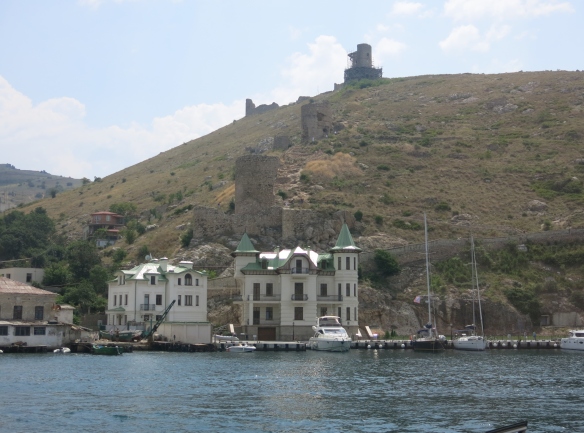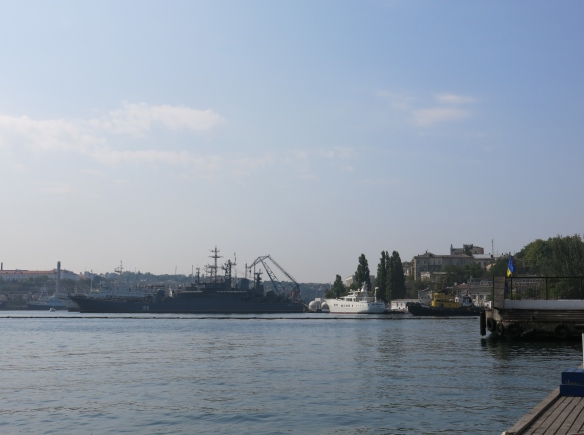The next time you’re playing parlor games and you want to stump everyone with a doozy of “Name this city!” ask this: What city can claim all of the following:
- The Charge of the Light Brigade
- Besieged during the Crimean War by a multi-national force led by the British, the entire Russian fleet at this port had to be scuttled to avoid falling into its enemies’ clutches
- A secret, Soviet underground submarine base during the Cold War
- The “other” major WWII siege of a Soviet city by the German army (hint: it’s not Stalingrad)
And if a BIG clue is required before the rotten eggs fly at you, here it is:
- This city’s harbors and bays on the Black Sea have a unique, military role as naval bases for two different countries: Ukraine and Russia.
Obviously, the title of this posting is the giveaway: Sevastopol is, of course, the answer. But I bet no one in a given parlor game of “Name this city!” would know even one of the above historical events. (Unless a stray Ukrainian was in the midst.)
So why bring these several random acts of history into a blog – and what were they? The first answer is: because the more I travel, the more I find history interesting. For the second answer, well, read on.
The Charge of the Light Brigade, Crimean War, 1854
The Crimean War
The Crimean War (1853-6) was a bit more complicated than Florence Nightingale bravely ministering to wounded soldiers on the field of battle. Essentially, the Crimean War was another in a series of internecine squabbles among European nations: the British and French got hot under the collar at Imperial Russia’s growing naval and military strength in and around the Black Sea. Ever since a Russian naval presence had been established in Sevastopol in the late 18th c., their western neighbors feared Russia would seize control of the Bosphorus and Dardanelles and encroach on Europe’s domination of the Mediterranean. Joined by the Ottoman Empire and Sardinia (and with occasional help from purportedly neutral Austria), this coalition lined up its land and naval forces against Imperial Russia. And despite a major disaster called the Charge of the Light Brigade, in which a British cavalry unit suicidally charged a major contingent of the Russian army, ultimately Russia lost the war.
A major blow to the Russians was the Siege of Sevastopol, 1854-5, where the Allies combined ground and naval forces wrested the city from the Russians after a series of six huge naval bombardments. The Russian Imperial Army retreated inland and thus survived to fight a few more futile battles. However, the czar’s pride, the Black Sea Fleet, was scuttled by the Russians to avoid having the vessels fall into Allied hands. The memorial below commemorates the loss of the warships, and was duly pointed out to us by our tour guide. While not the last battle in the Crimean War, the fall of Sevastopol did swiftly lead to the cessation of hostilities and a treaty the next year. Ultimately, Tennyson trumpeted the valor of the Brits in his epic poem, “The Charge of the Light Brigade,” while Russia memorialized the siege in the country’s first feature film (1911), The Defence of Sevastopol. (Not having seen the film, I can only wonder why anyone, especially a prideful country like Russia, would celebrate in film one of its greatest strategic defeats.)
Obviously, this synopsis is overly simplistic; there were significant consequences of the war that would influence world events for decades to come. But there were also non-military achievements as well. The Crimean War was the first to be documented extensively through reporting and photography. New technologies such as railways and the telegraph were used for the first time in a major conflict, and, yes, through the ministrations of nurses such as Nightingale, advances in medical care evolved.
WWII Siege of Sevastopol
Most educated persons of a certain age are familiar with the World War II German siege of Stalingrad, now called Volvograd. However, many people don’t know that Sevastopol was also besieged by the Germans, 1941-2, and, after some back-and-forth battles, this time the Germans won. In the process the Axis powers deployed ground, naval and air forces against the beleaguered city. The Luftwaffe, in particular, bombed the city so heavily that almost all the buildings were leveled.
Again, the goal of the Axis powers was to gain control of Sevastopol for its strategic naval position on the Black Sea. As in the days of the czars, the city’s protected harbors were home to the Soviets’ Black Sea Fleet. The Soviets had also established a major air base in the Crimean peninsula, the better to bombard Romania, one of Germany’s Axis members along with Italy and Japan. Eventually, of course, Germany lost the war and the Soviets regained their strategic Black Sea port.
Cold War Underground Submarine Base
The most interesting part of our tour was walking through the Soviet Union’s former underground submarine base in Balaklava. With a protected harbor opening onto the Black Sea, Balaklava had been a favorite acquisition since the time of the ancient Greeks. From the Middle Ages on, the port town had changed hands from the Byzantines to the Genoese, then the Ottomans, then Russia/Soviet Union, and now Ukraine.
In the growing Cold War nuclear build-up arising out of WWII, Stalin directed the construction of an ultra-secret, underground base for Soviet submarines, particularly nuclear ones. The result: an underground port carved out of a mountain on Balaklava Bay between 1957 and 1961. At its completion, the base could hold well over one hundred subs, and was so well fortified it could withstand a nuclear attack. The facility could not be seen from the sea, and the mountain surface was heavily camouflaged to avoid detection by satellite. Our guide told us that the entire area of Balaklava was one of the most secret and security-tight areas of the Soviet Union: townspeople who lived in Balaklava could not speak about the base, even among themselves, and no one was permitted into the area unless they could heavily document the dire necessity for visiting kinfolk in town.
Photo (in museum) of dolphin trained by Soviet Navy in Cold War to place detonators, cameras, recorders or trackers on naval vessels of all types.
The base remained active until after the dissolution of the Soviet Union; it closed in 1993. In fact, Russia formally ceded the abandoned base to the Ukraine in 2000; the base is now part of that country’s Naval Museum Complex.
And, yes, the name “balaklava” for the knitted face and head mask favored by commandoes, SWAT teams and ninjas comes from its usage by British soldiers in the Crimean War. The cavalry unit of the Light Brigade was part of the larger Battle of Balakava The origins of the word, however, are Turkish: baliklava,which means “fish nest.”
Naval Base to Two Countries
In one of those quirks of history, Sevastopol is the home base of the Ukraine Navy…and the Russian Black Sea Fleet. The need for a southern, warm-water port for Russian naval and commercial use was identified early on by Peter the Great and brought to fruition by Catherine the Great in 1783 when she annexed the peninsula to the Russian Empire.

Source: : http://en.wikipedia.org/wiki/File:Ukraine-growth.png
Post-WWI, parts of western Ukraine went to Poland, and the remainder – except for Crimea – became an independent nation…sort of. Ukraine cast its fate with the new Soviet Union as one of the its founding members, and remained pretty much under the “influence” of the USSR until that country’s dissolution in the early 90’s. Even though the Soviets nominally returned Crimea to Ukraine in the mid-50’s, the Soviet/Russian impact remained strong — as it continued to do so in this southern peninsula for the last 230 years. Ethnic Russians constitute 58% of the population of the peninsula, per the Ukrainian 2001 census, down from a high of 71% in 1959, but still a solid majority of the population. Moreover, a 2003 survey showed that 84.5% of people in the Crimea speak Russian as their first language and a 2005 survey showed 91% of the Crimean population supports designating Russian the official second language of the entire country. In both surveys, Russian ethnicity and language preference were significantly higher than in other parts of Ukraine, far more than those northeastern regions actually bordering on Russia. (If you’d like to check out these sources, go here, and here.)
Indeed, Ukrainian politics to this day are torn along an east-west axis: the western regions of the country demand greater alliance both politically and economically to the European Union, while the eastern provinces and Crimea want a stronger alliance with Russia. Given the strong Russian ethnic, language and military presence in Crimea, it’s not difficult to understand why 2009 saw several anti-Ukrainian demonstrations in Crimea by ethnic Russians.
One of the lasting symbols of this Russian-leaning sentiment in Crimea is demonstrated by a treaty between the two countries that permits Russia to base its Black Sea Fleet in Sevastopol until 2042. Thus, the vision of the Russian “Greats” remains a reality: Russia retains her warm-water port with access to the Black Sea, and thus retains her position of naval access to the world.






